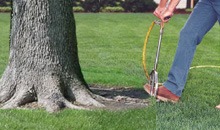Deep Root Fertilization in Memphis

The deep root fertilization process is to add vital nutrients back into the soil for tree absorption it promote the trees vigor and aids trees that may be under stress.
The advantages of using liquid type fertilizers are they have a slower release than granular liquids don't burn the tree. The tree's uptake is also faster with liquids. Another benefit is the high pressure the injector puts out reduces soil compaction which allows oxygen and carbon dioxide exchange.
